|
 Shale gas BASICS
Shale gas BASICS
Shale is a fine-grained, clastic sedimentary rock composed of
mud that is a mix of clay minerals and tiny fragments
(silt-sized particles) of other minerals, especially quartz,
dolomite, and calcite. The ratio of clay to other minerals
varies. Shale is characterized by breaks along thin laminations,
parallel to the bedding. Mudstones are similar in composition
but do not usually show layering within the zone.
The distinguishing characteristic of gas shales is that they
have adsorbed gas, just like coal beds. They also have free gas in
porosity, unlike coal, which has virtually no macro-porosity. The
adsorbed gas is proportional to the organic content of the shale.
Free gas is proportional to the effective porosity and gas
saturation in the pores.
 Sorption isotherms
Sorption isotherms
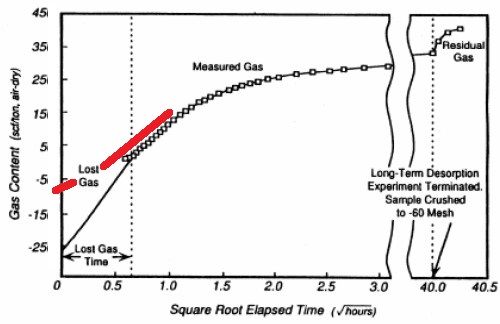 Sorption
isotherms indicate the maximum volume of methane that a gas
shale can
store under equilibrium conditions at a given pressure and
temperature. The direct method of determining sorption isotherms
involves drilling and cutting core that is immediately placed in
canisters, followed by measurements of the gas
volume (Gc) evolved from the shale over time. Sorption
isotherms indicate the maximum volume of methane that a gas
shale can
store under equilibrium conditions at a given pressure and
temperature. The direct method of determining sorption isotherms
involves drilling and cutting core that is immediately placed in
canisters, followed by measurements of the gas
volume (Gc) evolved from the shale over time.
<== Sorption isotherms for a gas shale, as measured
(Note that the lost gas estimate is absurdly optimistic
and
doesn't follow the measured trend toward zero time)
When the sample no longer evolves gas, it is crushed and
the residual gas is measured. A detailed description of the lab measurement of
adsorbed gas is provided in the CBM
Chapter.
Gas content (Gc) results are usually given as scf/ton or
cc/gram, as shown in the example lab report below. Multiply Gc in cc/gram by 32.18 to get Gc in scf/ton.
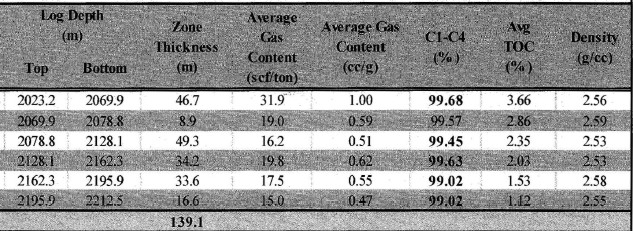
Example of Gas Content as measured in the lab in a shale
gas interval.
 GAS CONTENT Versus TOC
GAS CONTENT Versus TOC
TOC derived from log analysis models are
widely used as a guide to the quality of gas shales. Using
correlations of lab measured TOC and gas content (Gc). We can use
log analysis derived TOC values to predict Gc, which can then be
summed over the interval and converted to adsorbed gas in place.
Sample correlations are shown below.
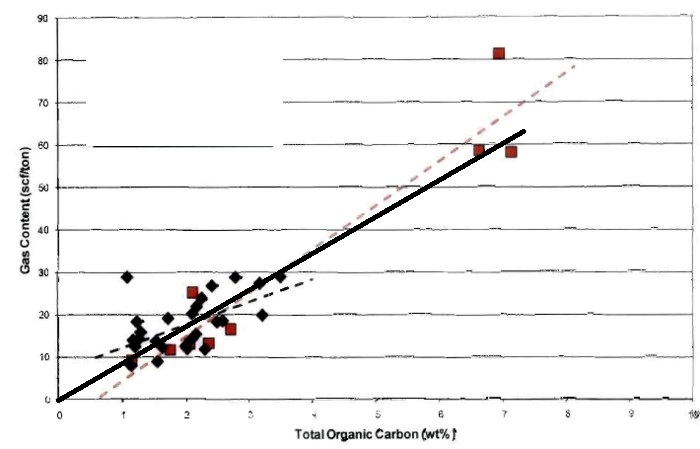 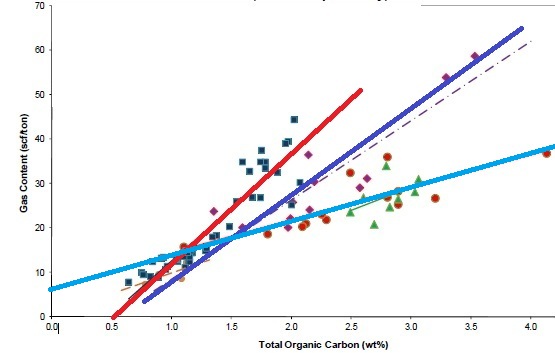
Crossplots of TOC versus Gc for
Tight Gas / Shale Gas examples. Note the large variation in Gc
versus TOC for different rocks, and that the correlations are not
always very strong. These data sets are from core samples; cuttings
give much worse correlations. The fact that some best fit lines do
not pass through the origin suggests systematic errors in
measurement or recovery and preservation techniques, and erroneous
lost gas estimates.
Gas content from correlation of core analysis data:
1: Gc = KG11 * TOC%
Where:
Gc = gas content (scf/ton)
TOC% = total organic carbon (weight percent)
KG11 = gas parameter, varies between 5 and 15
 SHALE Gas In Place -
adsorbed
SHALE Gas In Place -
adsorbed
Gas in place calculations in gas shales are done
in two parts: adsorbed gas and free gas.
Adsorbed gas in place is calculated from the actual gas
content found in the lab or from a correlation between TOC and
gas content (generated from lab measured data). Examples of both
data sources are shown below..
Gas in place is derived from:
2: GIPadsorb = KG6 * Gc * DENS * THICK * AREA
Where:
GIPadsorb = gas in place (Bcf)
Gc = sorbed gas from lab measured isotherm (scf/ton)
DENS = layer density from log or lab measurement (g/cc)
THICK = layer thickness (feet)
AREA = spacing unit area (acres)
KG6 = 1.3597*10^-6
If AREA = 640 acres, then GIP = Bcf/Section (= Bcf/sq.mile)
Multiply meters by 3.281 to obtain thickness in feet.
Multiply Gc in cc/gram by 32.18 to get Gc in scf/ton.
 COMMENTS
COMMENTS
Typical shale densities are in the range of 2.20 to 2.60
g/cc.
Recoverable gas can be estimated by using the sorption curve
at abandonment pressure (Ga) and replacing Gc in Equation 1 with
(Gc - Ga).
"ground
truth".
 SHALE Gas In Place - FREE
GAS
SHALE Gas In Place - FREE
GAS
Free gas in place is calculated from the usual
volumetric equations using the porosity and water saturations
developed by the kerogen corrected log analysis model:
22: Bg = (Ps *
(Tf + KT2)) / (Pf * (Ts + KT2)) * ZF
23: GIPfree = KV4 * (1 - Qnc) * PHIe * (1 - Sw) * THICK * AREA / Bg
24: GIPtotal = GIPadsorb + GIPfree
Where:
AREA = reservoir area (acres)
Bg = gas formation volume factor (fractional)
GIPfree = original free gas in place (Bcf)
GIPtotal = total gas in place (Bcf)
PHIe = effective porosity (fractional)
Sw = water saturation in un-invaded zone (fractional)
THICK = layer thickness (feet)
Pf = formation pressure (psi)
Ps = surface pressure (psi)
Tf = formation temperature ('F)
Ts = surface temperature ('F)
ZF = gas compressibility factor (fractional)
KT2 = 460'F
KV4 = 0.000 043 560
Qnc = fraction of gas that is non-combustible (CO2, N2,etc)
If AREA = 640 acres, then GIP = Bcf/Section (= Bcf/sq.mile)
Multiply meters by 3.281 to obtain thickness in feet.
|


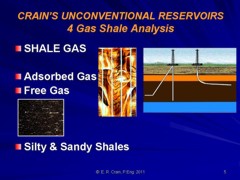
 Sorption
isotherms indicate the maximum volume of methane that a gas
shale can
store under equilibrium conditions at a given pressure and
temperature. The direct method of determining sorption isotherms
involves drilling and cutting core that is immediately placed in
canisters, followed by measurements of the gas
volume (Gc) evolved from the shale over time.
Sorption
isotherms indicate the maximum volume of methane that a gas
shale can
store under equilibrium conditions at a given pressure and
temperature. The direct method of determining sorption isotherms
involves drilling and cutting core that is immediately placed in
canisters, followed by measurements of the gas
volume (Gc) evolved from the shale over time. 

